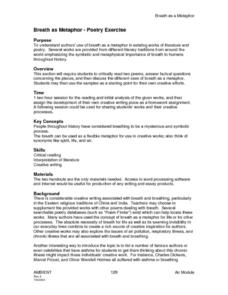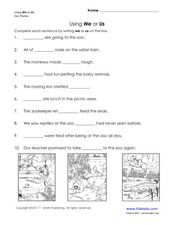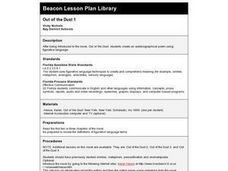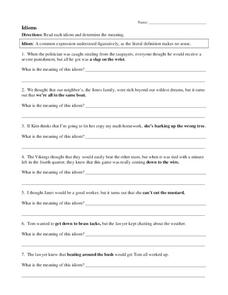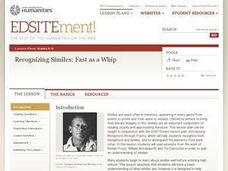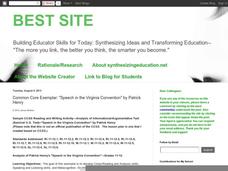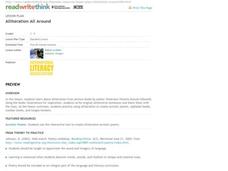Curated OER
Poetry: A Picture of Feelings
Students take a field trip to a place of interest. After the trip they share with a partner their most memorable memory about it. Later, they paint a picture representative of the trip and illustrate it with a poem using at least two...
Curated OER
Breath as Metaphor - Poetry Exercise
Students are required to critically read two poems, answer factual questions concerning the pieces, and then discuss the different uses of breath as a metaphor. They use the samples as a starting point for their own creative efforts.
Curated OER
Onomatopoeia
Students explore the use of onomatopoeia using comics. They develop a list of onomatopoeia examples, write sentences, complete a worksheet, and create a comic strip using onomatopoeias.
Curated OER
Polar Bear Literacy Activity
Young scholars generate vocabulary words synonymous or related to "noise." In this literacy lesson, students listen to the book Polar Bear, Polar Bear, What do You Hear? by Bill Martin and Eric Carle and discuss the meaning of vocabulary...
Curated OER
Color Poems
Students describe colors. In this descriptive writing lesson, students brainstorm color descriptions using all of the senses except sight. Students write poems including similes, sensory images, and interesting word choice. Examples are...
Curated OER
Dream Houses
Students imagine and create their dream house. For this comprehension and interpretation lesson, students read The Big Orange Splot, answer comprehension questions about the story and complete a character traits web. Students describe...
Curated OER
Onomatopoeia
In this onomatopoeia worksheet, students read the directions and examples for this literary device. Students brainstorm, then write some sentences. Finally they write a comic strip using onomatopoeia, and illustrate it.
Curated OER
Haiku Wrap Up
Students create a haiku about the land formations they've studied. In this haiku lesson, students identify the metaphor and meaning of a given haiku, brainstorm comparisons for a landform photo as a class and choose one to use in a...
Curated OER
Onomatopoeia Poems
Students write onomatopoeia poems. In this creative writing instructional activity, students listen to a picture book that introduces the concept of onomatopoeia. Students create their own list of words and write a short poem using...
Curated OER
Using We or Us
In this grammar worksheet, students read 10 different sentences and figure out if the sentence should contain the word "we" or "us."
Curated OER
Out of the Dust 1
Pupils review figurative languages terms and examples. They read the first entry in the book, Out of the Dust, and discuss the images created by the author. Then they create an autobiographical poem using figurative language.
Curated OER
Idioms
In this idioms practice worksheet, students examine 9 idioms and their meanings. Students then use 6 of the idioms to give advice in 6 scenarios.
Curated OER
Recognizing Similes: Fast as a Whip
Students review basic knowledge of similes and engage with similes on a more abstract level. In this similes activity, students define similes and identify examples. Students read and analyze the similes used in poetry by Derricotte,...
Curated OER
Metaphors
In this metaphors worksheet, students practice writing sentences using metaphors. Students are given fifteen adjectives that describe someone and students use a metaphor to write a sentence about the adjective.
Curated OER
Paco's Similes
Learners engage in a activity which focuses on using conversational language and music to introduce the concept of similes, building language acquisition and helping create a positive attitude toward knowing and learning more than one...
Curated OER
Irony in Poetry and Prose (Fiction and Non-fiction Texts)
Middle and high schoolers examine the impact of irony in poetry and prose. In this figurative language lesson, they read instructor-selected literature and identify uses of irony. Then they discuss how irony enhances literature.
Curated OER
Speech in the Virginia Convention
“. . .different men often see the same subject in different lights. . .” but the great orator Patrick Henry used all the skills at his command to craft a speech to convince listeners to see things as he did--that liberty was worth dying...
Curated OER
Pride and Prejudice: Concept/Vocabulary Analysis
Clarify the setting, literary themes, and potential vocabulary issues with a concept analysis resource. With thoughtful explanations of many parts of Jane Austen's Pride and Prejudice, the reference sheet will be a great addition to your...
Curated OER
Transformations in the Coordinate Plane
Your learners connect the new concepts of transformations in the coordinate plane to their previous knowledge using the solid vocabulary development in this unit. Like a foreign language, mathematics has its own set of vocabulary terms...
ReadWriteThink
Alliteration All Around
Discover alliteration found in picture books by Pamela Duncan Edwards. Then, dive into a read aloud of Alligators All Around by Maurice Sendak. This practice sets the stage for budding poets to create their own acrostic poem, write an...
EngageNY
Analyzing Text Structure: “Water Is Life” Paragraphs
Water, water everywhere. Readers revisit paragraphs six through nine in the article "Water is Life" to answer text-dependent questions. They then pair up to reread the article focusing on its structure and record their thoughts on...
Curated OER
Who Am I?
Get to know a person in your class or a famous figure in history. With questions about the person's birthplace, parents, and what they are famous for. A space at the bottom prompts writers to list three things they have learned.
Learner
Solid Shapes
A collection of two lessons, kindergartners will identify two-dimensional shapes in solid shapes. They will develop basic knowledge of the components that make up a sphere, rectangular prism, pyramid, cylinder, cone, and cube. Young...
Curated OER
"Shooting An Elephant": George Orwell's Essay on His Life in Burma
High school readers examine George Orwell's essay "Shooting an Elephant" for examples of symbolism, metaphor, connotation, and irony. They analyze how these literary tools convey the writer's main point and contribute to the persuasive...



